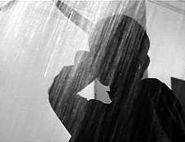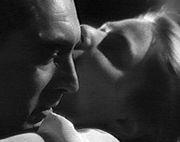The Art of Murder
article by Iain Morrisson
Before the "shower scene" in Psycho, Alfred Hitchcock had directed only three other sustained murder sequences. The vast majority of murders in Hitchcock's movies occur either off-screen, or they are as brief as the flash of a gun. The three prolonged sequences prior to Psycho include the stabbing of Crewe in Blackmail, the stabbing of Swann in Dial M for Murder, and the strangling of Miriam in Strangers on a Train.
The Feminine Gaze in Notorious and The Paradine Case
article by Elizabeth Abele
Though the privileging of the male spectator and gaze may exist in Vertigo and Rear Window, Hitchcock's use of the gaze is generally more complicated. Though a male gaze perspective may be present, the controlling gaze in several films is actually female. In these films, Hitchcock's female gaze may be as objectifying and controlling of the man as a male gaze is to a woman, while in other cases it exists as a knowing, patient and protective gaze. To examine Hitchcock's use of a secondary, non-male gaze, I will discuss two films from his Selznick period (1940-49): Notorious (1946) and The Paradine Case (1947). Hitchcock's use of the feminine gaze gives his female characters power, agency and depth--despite Hitchcock's self--cultivated reputation as a misogynist.
Alfred Hitchcock's WWII French Films and the Limits of Propaganda
article by Dr. Kenneth Rivers
At the peak of his career, Alfred Hitchcock, renown for his British and Hollywood-made suspense cinema, diverged from his usual formula to make two French language adventure movies designed as World War II propaganda films. Made in 1944, Aventure malgache (which translates as "Madagascan Adventure") and Bon Voyage remained virtually unseen until a 50th anniversary re-release and subsequent video distribution. These two short films may well be the most challenging films to assess in the entire Hitchcock filmography, for their overt goal of propaganda establishes a set of expectations alien to Hitchcock's suspense films, thus creating conflicts for the filmmaker and the critics alike.
Vertigo: Love, Desire, the Image, and the Grave
article by Robert Baird
Vertigo is devoted to the dream of reanimating the dead. This desire is fed through the supernatural possibility of reincarnation of Carlotta through the possession of Madeleine, but this is later exposed as merely a conceit of an elaborate murder plan. One manner of preservation that is never discredited, however, is the power of dreams, words, stories, and images to preserve--even bring
to life--the beloved dead. Madeleine/Judy, for example, studies Carlotta's portrait in order to bring Carlotta to life.
The Parlor Scene from Psycho: Images of Duality
article by Michael Schmidt
Though tame by today's standards, Alfred Hitchcock's Psycho has done more to advance the horror genre (slasher films in particular) than any other film of its time; however, the brilliance of Psycho does not lie in its abhorrent concept, but rather in the way that Hitchcock melds the obvious and the mysterious. Indeed, in one of the most revealing scenes, just one third of the way through the film, Hitchcock is outrageously obvious in his intentions; yet his artistry in lighting, camera angle, and mise-en-scene make it possible to hide in plain sight and create a world that is rife with duality.




